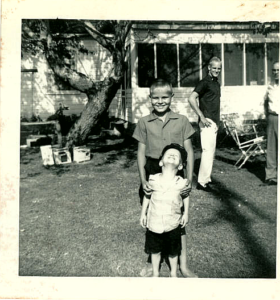
Seinfeld added a large number of terms to the English language. One of these is “shrinkage,” but the shrinkage that is the subject of today’s piece has nothing to do with cold water in swimming pools.
If you’re like most Boomers, you don’t live in the same house in which you grew up. You probably don’t even live in the same town. In my case, I left Miami, Oklahoma at the age of eight. Though we made return trips there more or less regularly until I was sixteen or so, when I revisited the place in 1994, it was for the first time since I was a kid.
My, how the place had shrunk!
When you’re a kid, the world is a big place. You’re used to looking up at mom and dad. You’re used to standing on stools, chairs, and other makeshift ladders in order to reach things that adults can grab with ease. The concept of having things naturally fit your form is a foreign one. One of the few exceptions was the desks we sat in at grade school. They were perfect.
Growing up is a gradual process, to be sure. We don’t notice that we can now reach things we used to have to improvise on-the-fly-solutions in order to accomplish the same thing. The teenaged growth spurts that many of us males experienced might be the exception to that, I knew kids that grew three inches in a single summer. But for the most part, we just don’t notice that the world is, in fact, shrinking.
However, if we take a trip back to our hometown, it hits us. Hard.
I currently live in Bentonville, Arkansas, a town that has been experiencing growth for forty years. I imagine a kid returning here would have a hard time picking out anything he or she would recognize from their youth. The city pool is now a parking lot. The library is gone, replaced by an office building. The apple orchards that were everywhere in the 70’s are now subdivisions.
You get used to growth after a while, but the fact is that many places have stagnated, making revisits less alien to the former child.
Such is the case with Miami, Oklahoma.
On my 1994 trip, I began looking for landmarks. The drive-in theatre was gone, not even an abandoned screen left standing. But the Ku-Ku diner was still there, its giant cuckoo clock look still intact. Somehow it seemed a bit smaller, though.
I made a left turn at BJ Tunnell Blvd., which was called something else in the 60’s. I drove down the road to my dad’s old truck garage, housed in a WWII-era Quonset hut. It was tiny. When I was a kid, that place was big enough to park a B-52 in. Now, I fail to see how a semi tractor could ever squeeze in, although I remember there being two at a time in there.
It was time to turn around and seek out the house at 826 K NW. I headed back up the boulevard and turned left on K St. I parked my vehicle and tried to make sense of what I saw.
The lot on which sat my childhood home had somehow been transformed from a vast estate to a postage stamp. How could that happen? That side yard had been long enough to host a 100 yard football field, now it appeared to be perhaps 200 feet in total length.
Then, there was the house itself. It had been added onto, perhaps a third bigger than it used to be. I had a hard time recalling its appearance when LBJ was the President. But eventually, it all came together.
That driveway, once big enough to hold an entire platoon of GI Joe’s troops, was now a tiny patch of cracked concrete barely big enough for my little Toyota pickup. How did dad ever park a spacious Plymouth Fury III there?
The front yard was a tiny patch as well. That thing was once big enough to hold an army of kids playing, well, army. Now, it looked like you could cover it with four bedspreads.
That front porch had shrunken to a piece of concrete barely big enough to stand on. The front door didn’t look big enough to carry an easy chair through.
I’d had enough. I got back in the truck and drove uptown. Yep, just like I thought, Farrier’s IGA (now named something else) had gone from a vast expanse of retail squalor to a market 1/4 the size of a typical Wal-Mart. Riverview Park, formerly at least a thousand acres of vast greenery, was now a modest-sized collection of picnic tables, playground equipment, and parking places.
My stay lasted a few more hours, but I think you get the point. Can someone explain to me the physics behind the entire world of the 1960’s being about twice the size of the one we now inhabit?
Oh, I see I have a Facebook chat request from my fellow fossil-collecting buddy in Spain. Excuse me…